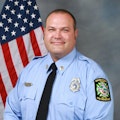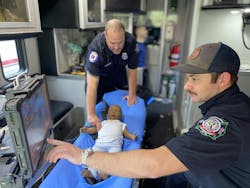Mobile Simulation Labs: Making EMS Training More Engaging and Accessible
Key Takeaways
- Converting a rescue rig into a mobile EMS simulation lab provides field personnel with realistic practice for low-frequency/high-acuity EMS calls without the need for those people to leave their firehouse.
- Ideally, topics to be covered in EMS training emerge at least in part from feedback from EMS group meetings.
- Utilization of portable training props make EMS training as hands-on and as realistic as possible.
Nearly 85 percent of the Seminole County, FL, Fire Department’s (SCFD) emergency responses are classified as EMS in nature. The need for relevant, efficient and engaging medical training is more essential than ever.
To help to address this need, the SCFD recently began to field a Mobile Simulation Lab to provide crews with enhanced, in-depth EMS training and recertification opportunities right inside of the bay doors at all of the department’s 20 stations.
Retrofitting a rescue rig
The brainchild for the “Sim Lab” began in 2017, when the EMS Division chief, Matt Kinley (who is the current fire chief), was looking for a way to increase EMS training while keeping crews within their response areas so that they could be dispatched to high-priority calls if needed.
The Sim Lab, which was converted from a retired rescue chassis, leverages simulation and monitoring technology to provide firefighters with realistic, hands-on training opportunities that go beyond the kind of instruction that they might receive in a traditional classroom setting.
The back of the Sim Lab is laid out similarly to a rescue unit and is where crews practice lifesaving techniques on one of three advanced manikins. Trainers watch from the cab via six embedded cameras. Instructors can provide live voice feedback to crews and record footage for review following the scenario.
For the conceptual stage of the Sim Lab, the biggest challenge was procuring the equipment for the interior. Retrofitting a rescue rig with this technology also created some challenges, particularly from a fitment standpoint.
Mobile implementation
The Sim Lab launched nearly a year ago. The department has aimed to visit four stations per day (all in the same battalion area) in a traditional 40-hour work week. Two firefighter/paramedic instructors lead a one-hour training. The department strives to reach all of its personnel on a particular topic every month.
In 2024, the SCFD conducted 17,000 hours of EMS training at the Seminole County Fire Training Facility, which includes recertification, practical and didactic components, and medical director meetings. The Sim Lab provides a mechanism to increase EMS training by 5,500 hours, or a 32 percent increase compared with previously. A bonus: Many of these lessons serve as continuing-education units.
Thus far, topics included advanced airway management, neuroprotective CPR, treatment of extremity injuries and hemorrhaging. All levels of care are attempted to be covered, from basic life support skills to complex and advanced cases. Topics are planned based on feedback from EMS group meetings and seasonal matters, such as reviewing heat emergencies in June.
Feedback onsite
Utilizing the feedback manikins has been a great benefit to conducting a high-fidelity simulation to ensure correct medication and dosage administration, ventilatory efficacy, etc. Because trainings are set up in the same way that the crew would run a call—without instructor interference—personnel run scenarios without interruptions. Instructors are able to talk through the manikins to give personnel real-time responses from the “patient” to the trainees’ questions.
Afterward, debriefing is conducted in the station to see firsthand what aspects worked and where improvement is needed.
A huge advantage: The scenarios allow field personnel realistic practice for low-frequency/high-acuity EMS calls.
From an operational standpoint, the Sim Lab positively influences resource availability and saves crews travel time to and from the department’s training center. This contributed to an overwhelmingly positive response from personnel.
Ultimately, we have had an overwhelming response from personnel. This includes in regard to scenarios that we run (e.g., acute cardiogenic pulmonary edema, bleeding control, carbon monoxide inhalation and cyanide positioning) and our utilization of portable training props, such as wound-packing cubes for bleeding control, to make the training as hands-on and as realistic as possible
Tips for a Successful Mobile Simulation Lab Launch
Staffing. Ensure that passionate and knowledgeable instructors who have a good rapport with field personnel are involved. Mix it up with paramedics of varying experiences, to have different skill sets and to appeal to various audiences.
Train the trainers. Organize one day per month when all instructors meet to review practice parameters for the quarter to ensure consistency.
Conduct surveys. Solicit feedback from personnel and instructors on what works and what doesn’t.
Avoid these pitfalls
· Don’t have too many “cooks in the kitchen.” Streamline the process so that the lead project manager delegates directly to the team. From a chain-of-command standpoint, the project manager should report directly to an appropriate supervisor (e.g., an EMS battalion chief) to provide updates, streamline approvals, etc.
· Teach, don’t preach. Make sessions engaging and allow room for the crews to feel comfortable to ask questions.
· Don’t wait for perfection. You might not have the “best” of everything or all of the needs in place for how your agency wants to pursue a mobile simulation lab but start the process if you believe that your department will benefit. Make sure to have someone at the helm to champion the project and delegate accordingly.
Product Spotlight
Automated CPR
Defibtech’s ARM XR is an automated chest compression (ACC) device that helps first responders to deliver continuous, high-quality CPR for patients who are in cardiac arrest. Rugged, dependable and with exceptional battery life, ARM XR deploys in seconds and maintains continuous compressions over long durations and during transport.
DEFIBTECH.COM
Prehospital Field Tourniquet
Prevent death from major bleeding with the genuine Combat Application Tourniquet. It’s the most studied, most safe, fastest 100 percent-effective prehospital field tourniquet in the world, the company says, and is utilized by all branches of the military as well as law enforcement and public safety services. If your C-A-T Tourniquet isn’t manufactured in the United States, it’s a fake. Get your genuine C-A-T Tourniquet only from North American Rescue or its authorized distributors.
NARESCUE.COM/CAT-TOURNIQUET
About the Author

Matt Humphrey
Matt Humphrey serves as a firefighter/paramedic for the Seminole County, FL, Fire Department. He is the project manager for the department’s Mobile Simulation Lab and the lead paramedic instructor. Humphrey has more than two decades of experience.
